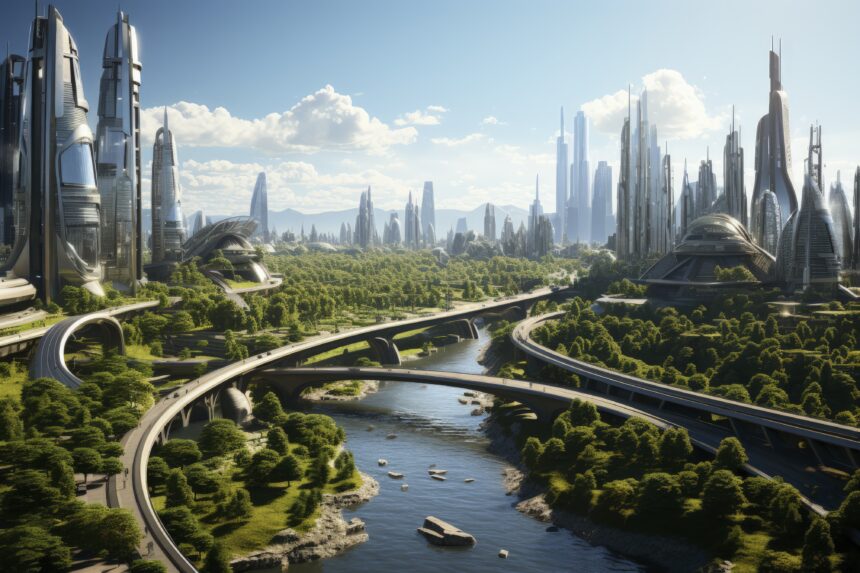As urban populations grow, cities face immense challenges—pollution, resource depletion, and climate change. Traditional construction methods have contributed significantly to carbon emissions, energy waste, and environmental degradation. However, green building practices are transforming urban development, creating cities that are eco-friendly, energy-efficient, and resilient.
In this article, we’ll explore how sustainable building practices are reshaping modern cities, the latest innovations in green architecture, and the future of urban development.
The Need for Sustainable Cities
Urban areas are responsible for over 70% of global CO₂ emissions and consume nearly 60% of the world’s resources. Without intervention, increasing urbanization will put tremendous strain on the environment. Key challenges include:
a) Rapid Urbanization & Population Growth
- By 2050, nearly 70% of the world’s population will live in cities.
- Unplanned urban expansion leads to traffic congestion, pollution, and inefficient infrastructure.
b) High Energy Consumption & Carbon Emissions
- Buildings account for nearly 40% of global energy use.
- The use of fossil fuels for heating, cooling, and electricity significantly contributes to climate change.
c) Water & Resource Scarcity
- Many cities struggle with water shortages, inefficient waste management, and deforestation.
- Conventional buildings consume large amounts of raw materials, increasing environmental stress.
d) Climate Change & Urban Resilience
- Rising sea levels, extreme weather, and heatwaves threaten coastal and inland cities.
- Many cities lack climate-resilient infrastructure, making them vulnerable to natural disasters.
To combat these challenges, urban planners and architects are turning to sustainable building practices to create greener, smarter cities.
What is Green Building?
Green building, also known as sustainable architecture, refers to environmentally responsible construction that minimizes energy consumption, reduces waste, and promotes eco-friendly materials.
Key Principles of Green Building:
- Energy Efficiency: Buildings designed to use less energy for heating, cooling, and lighting.
- Water Conservation: Systems that reduce water waste and improve efficiency.
- Eco-Friendly Materials: Use of sustainable, non-toxic, and recycled building materials.
- Smart Design & Technology: Integration of renewable energy and smart systems to optimize performance.
- Biodiversity & Green Spaces: Incorporation of urban greenery, green roofs, and sustainable landscapes.
Green Building Innovations Reshaping Urban Development
a) Energy-Efficient Architecture
- Passive Solar Design: Buildings are oriented to maximize natural sunlight, reducing reliance on artificial lighting.
- High-Performance Windows & Insulation: Improves temperature control, cutting heating and cooling costs.
- LED & Smart Lighting Systems: Energy-efficient lighting that adjusts based on occupancy.
Example: The Edge in Amsterdam is one of the world’s greenest office buildings, using smart lighting, solar panels, and energy-efficient design to reduce energy use by 70%.
b) Renewable Energy Integration
- Solar Panels & Wind Turbines: Buildings generate their own clean electricity.
- Geothermal Heating & Cooling: Uses underground heat for efficient temperature control.
- Net-Zero Buildings: Producing as much energy as they consume.
Example: The Bullitt Center in Seattle is a net-zero energy building, generating its own power through solar panels and rainwater collection.
c) Smart Water Management
- Rainwater Harvesting Systems: Collects and reuses rainwater for irrigation and flushing.
- Greywater Recycling: Treats wastewater for non-drinking purposes.
- Low-Flow Plumbing Fixtures: Reduces water consumption.
Example: Singapore’s Marina Barrage manages water supply and flood control while integrating green spaces.
d) Sustainable Building Materials
- Recycled Steel & Wood: Reduces environmental impact.
- Bamboo & Hempcrete: Strong, renewable alternatives to traditional materials.
- Cool Roofs & Reflective Materials: Lowers urban heat levels by reflecting sunlight.
Example: The Bank of America Tower in New York was built with recycled steel and sustainable concrete, reducing CO₂ emissions.
e) Green Roofs & Vertical Gardens
- Reduces heat absorption, improves air quality, and provides insulation.
- Increases biodiversity in urban areas by creating habitats for birds and insects.
Example: Milan’s Bosco Verticale (Vertical Forest) integrates over 900 trees and 5,000 plants into its high-rise structures, improving air quality.
f) Smart Cities & AI-Driven Sustainability
- AI-powered energy grids optimize power distribution and consumption.
- Smart transportation systems reduce traffic congestion and emissions.
- IoT-enabled sensors monitor air quality, water usage, and building efficiency.
Example: Singapore’s Smart Nation initiative integrates AI and green technology for sustainable urban living.
Benefits of Green Building in Cities
Environmental Benefits
- Reduces carbon footprint and energy consumption.
- Preserves natural resources and improves air and water quality.
- Minimizes waste production through recycling and efficient materials.
Economic Benefits
- Lowers energy and water bills for residents and businesses.
- Increases property value and attracts eco-conscious investors.
- Creates green jobs in renewable energy and sustainable construction.
Social Benefits
- Improves indoor air quality, reducing health risks.
- Enhances urban aesthetics and public well-being.
- Provides more green spaces, promoting community interaction.
Challenges of Green Building & How to Overcome Them
While green building is promising, several obstacles remain:
| Challenge | Solution |
|---|---|
| Higher initial costs | Government incentives and long-term savings offset costs. |
| Lack of awareness | Public education and sustainability campaigns. |
| Limited policies & regulations | Stronger environmental laws and urban planning policies. |
| Technology adoption barriers | Incentives for businesses to integrate green technology. |
Many cities are addressing these challenges by offering tax breaks, subsidies, and grants for green buildings.
The Future of Sustainable Cities
The shift toward green urban development is gaining momentum worldwide. Future trends include:
- 100% Renewable Energy Cities – Copenhagen and Reykjavik are aiming for complete reliance on renewable energy.
- Smart & Resilient Cities – AI-driven cities will monitor pollution, traffic, and waste management in real-time.
- Circular Economy in Construction – Zero-waste construction projects will recycle and reuse building materials.
- Carbon-Neutral Skyscrapers – High-rises built entirely from sustainable, low-carbon materials.
Final Thoughts: Building a Greener Future
Green building is not just an option—it’s a necessity for sustainable urban development. By integrating energy-efficient designs, renewable energy, smart technology, and eco-friendly materials, cities can reduce their environmental impact, improve quality of life, and promote economic growth.
As more governments, businesses, and individuals adopt sustainable building practices, the dream of carbon-neutral, self-sufficient cities is becoming a reality. The future of urban development is green, smart, and sustainable—and the time to act is now.
FAQs
1. Are green buildings more expensive to build?
Initially, yes, but long-term savings on energy and maintenance make them cost-effective.
2. Can green buildings work in extreme climates?
Yes! Sustainable designs adapt to different environments, using insulation, shading, and renewable energy.
3. What certifications recognize green buildings?
Popular certifications include LEED (USA), BREEAM (UK), and Green Star (Australia).
4. How do green buildings impact health?
Better air quality, natural lighting, and reduced toxins improve overall well-being and productivity.
5. Will all cities adopt green building practices?
Many cities are already implementing policies, but widespread adoption depends on government incentives and awareness.




